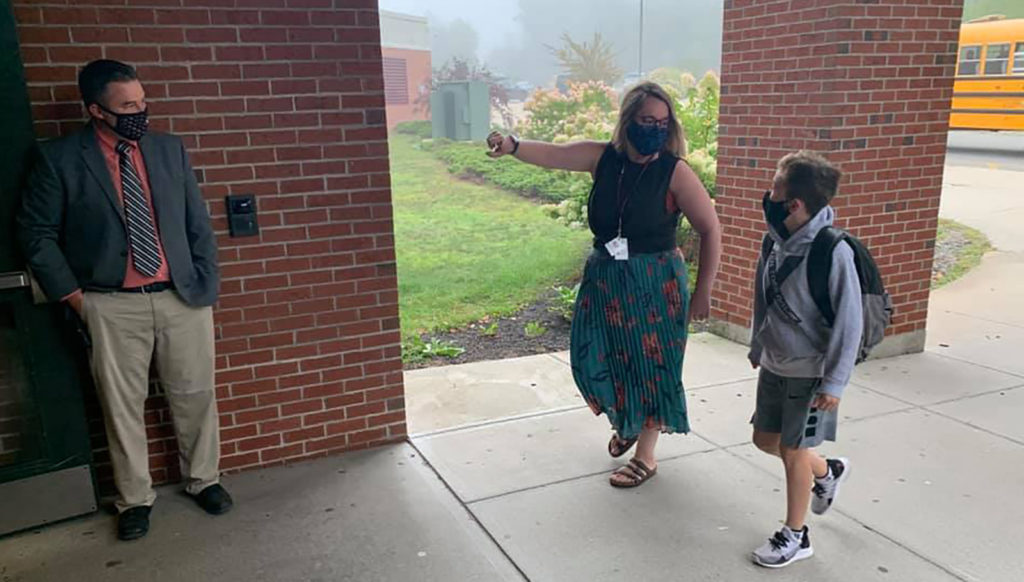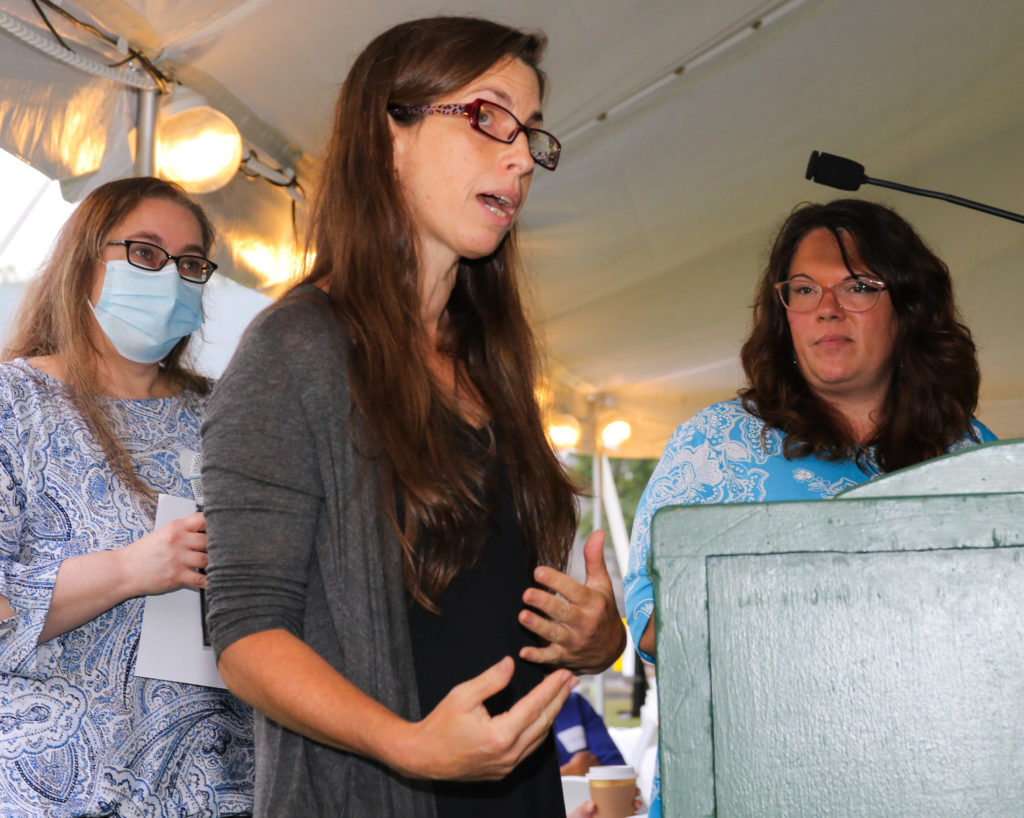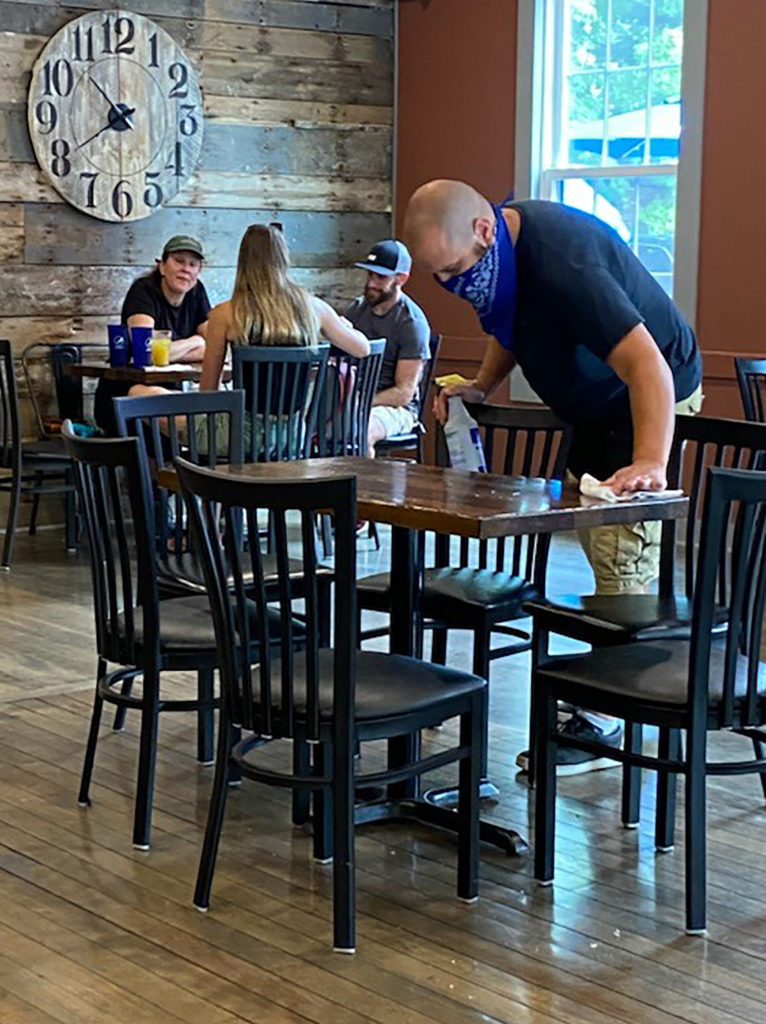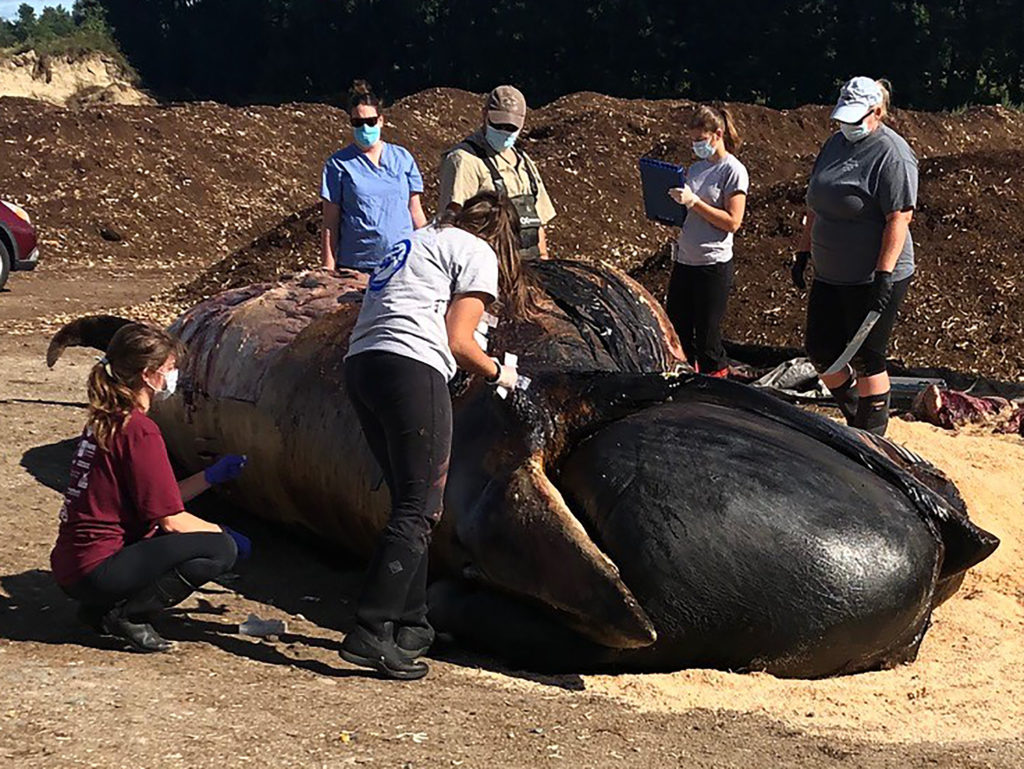Archive for September 2020
Crafting the 2020-21 school year for Gorham under COVID-19

By Nathan Tsukroff
GORHAM – Crafting the 2020-21 school year for the Gorham School District began last spring, as schools were shut down under the initial rules brought on by the COVID-19 pandemic.
There were lots of decision to be made. Would schools only offer remote learning in the fall, or fully in-person classes, or a combination of the two? How many students would attend in-person, and how would they be kept safe under the social-distancing guidelines?
Superintendent Heather Perry, starting her sixth year in her position, said committees started planning in earnest in mid-May, “once we got settled” after the emergency shut down in March.” We began really thinking about, how do we open school again, because we know we’re going to shut down school for the summer.”
Several committees worked on plans for this new school year, including the District Leadership Team, which is made up of all the principals, assistant principals and program directors in the district, a medical advisory group, made up of the school physician, district nurses, and four local physicians. The school committee was also involved, and was given documents and other information for members to provide feedback on the decision-making process.
“It was a very fluid and flexible process, with those major committees playing leadership roles,” Perry said.
“We also did some significant surveys with our parents at the end of the school year in June, to try to get feedback from parents around what their thoughts were on what was working well or wasn’t for remote learning.” Parents were also asked for their thoughts and concerns about safety issues with in-person learning. The district had “great participation” with three full-scale surveys among parents, staff and community members, she said.
“It was an iterative process,” where the district presented ideas and thoughts to staff and parents for their feedback, Perry said. “And that went on for several months.”
The Maine Department of Education created three scenarios for schools to re-open in the fall – “Red” for only remote learning, “Green” for all in-person classes, and “Yellow” for a hybrid mix of the two.
“Our focus all along was preparing for the Yellow opening, because we knew that was the hardest one to plan for, and the hardest one to make happen,” Perry said.
The color designations for schools differ from the color designations the State of Maine created for counties. The state color designations provide citizens with an understanding of the level of COVID-19 spread and infections in a county. For example, York county is currently designated as a yellow county due to a recent upsurge in infections, while Cumberland county remains green. Gorham sits in western Cumberland county, on the border with York county.
Perry said she shared plans and documents with other superintendents in the Cumberland County Superintendents Association, which met three times a week after schools were shut down in the spring. By June, meetings were just weekly, as the districts continued to share ideas, thoughts and questions as schools looked to re-open. A representative from the MDOE usually joined the meetings, and “often times, it was the commissioner of education herself (Pender Makin) who joined our meetings.”
While the different needs for each school district, such as in facilities and transportation, meant each district had to craft a unique plan, the superintendents worked together to ensure continuity among the schools. This was especially important for the Career and Technical Education program, where students attend classes in Westbrook, Perry said. Gorham chose Friday as a day for only remote learning, to coordinate with Westbrook.
The Gorham School District has about 2780 students, and just over 10%, or about 290 chose full remote learning.
Because of the size of the classrooms and the need to keep students properly distanced for their safety under pandemic guidelines, Gorham schools were not able to allow all students on campus at one time. Students were placed into two cohorts, or groups, with the A group students in school each week on Monday and Wednesday and the B group attending weekly on Tuesday and Thursday. Both groups do remote learning on Fridays.
At Great Falls Elementary School, with a student population of about 580, around 280-290 students are in school at one time under this plan. This means students have enough room to remain six feet apart when they remove their face masks at lunchtimes, Perry said. For “580 kids, we can’t do it. There’s not enough real estate!”
For the Gorham schools, students are using the cafeteria and other areas in the school for meals, Perry said. This was important because “we wanted kids to still be able to get in a social situation, where they could interact with their peers outside of their (classroom) group, safely.” Meal areas are sanitized between each serving, and “there are a lot safety protocols that are being put into place.”
Having students leave the classrooms for lunch also gives teachers time to themselves. Personal breaks are “an important aspect of being a good, high-quality functioning teacher,” Perry said. The district will continue to look at how students are served lunch, and make changes as needed.
The decision to alternate attendance days means that students are not away from the school building for more than five days, Perry said. This creates “a rhythm of learning that made sense for us.”
Another reason for keeping students and staff out of school buildings on Fridays is to provide about 72 hours to allow for the expiration of any virus that remains on surfaces after the daily sanitations. This means the schools have a fresh start each week, Perry said.
The medical needs and concerns of teachers and other staff members were reviewed and accommodated over the summer, with minimal changes in staffing for the district for this school year, she said. “At this point in time, we really are very, very lucky. I think we’ve only got a very small handful of staff who are on medical leave of one variety or another because of COVID. And the rest we’ve been able to figure out a way to accommodate” them so they can continue their work for the district.
Staff members have been assigned various roles to help with the remote learning, some working with students completely remotely, and others alternating between classroom teaching and remote teaching.
As with other schools in Cumberland county, football and indoor volleyball have changed for this fall. Gorham will have “more of an intra-mural approach” with students practicing and building skills only at their own school. An outdoor volleyball court is being created for student practice, and the football program is looking at possible flag-football games.
Other fall athletic events will take place between schools, under the Maine Principal Association guidelines.
The Gorham School District includes Gorham High School, Gorham Middle School, Great Falls Elementary, Narragansett Elementary and Village Elementary.
Before coming to Gorham, Perry was the superintendent for nine years at Maine Regional School Unit 3, centered in Unity. She is originally from the Machias area, where she was a teacher and school principal.
Lewiston schools create new school year with pandemic restrictions

By Nathan Tsukroff
LEWISTON – A commitment by the Lewiston Public Schools in the spring of 2020 to give parents a choice of in-person or remote schooling was “kind of our springboard” to crafting the new school year under the restrictions brought on by the COVID-19 pandemic.
“We knew that we were going to have the remote option, and we were going to have to find out which parents wanted which option” for classes starting in the fall of 2020, according to newly-appointed Superintendent Jake Langlais.
Langlais took over as interim superintendent for the schools in July when previous Superintendent Todd Finn resigned for health and personal reasons after just a year in the position. Langlais had been the Lewiston High School principal since 2017, and was previously principal at the Lewiston Middle School.
“And then when we looked at the physical size of our district, and at least the estimate, at the time, of who wished to be remote, we had as many as the high 70’s and low 80’s percent” of parents who wanted their children to attend school in-person, he said. “So when the (State of Maine) guidelines came out at the end of July, we looked at our projection of students that we thought wanted to come to school, and we took that number and started looking at the social-distancing requirements. And that’s when we knew that if this number stays that big, or gets bigger, we were going to have to cut this group in half somehow.”
At the same time, the school district was looking at providing additional support for students, and trying to determine how to provide office hours for teachers to be available for students. “And also some planning around social/emotional” needs of the students as they deal with the stress and trauma of dealing with the pandemic, Langlais said.
“And so that led us to say, okay, if we’re splitting our groups, what’s the best way to do this? Is it an alternating – is it a Monday/Tuesday, nothing Wednesday, then a Thursday/Friday?” he said. “The picture started to paint itself, because we landed in a place where our available staff and our parent desire to be in school” pointed to two cohorts, or groups of students, that would attend split sessions at the schools.
The district also looked at students who might have special education needs, and students who would attend the Lewiston Regional Technical Center, which provides “a pretty specialized program” for students from six schools in the area, Langlais said. The requirements of the programs at LRTC generally means students must attend in-person four days a week.
That led the district to create four cohorts, starting with cohort A, which attends classes in-person on Monday and Tuesday each week, with remote learning on Wednesday, Thursday and Friday. Cohort B attends in-person on Thursday and Friday, with remote learning on Monday, Tuesday and Wednesday.
Students who opted for only remote schooling make up Cohort C. These students are being taught mostly by dedicated teachers who are doing just remote classes,” he said. “In most cases, we had enough students who wanted to be remote that we could take a group of teachers and have them do just remote teaching.” More than 100 students each at the elementary schools, “and a pretty high number (of students) at the middle and high school” have chosen remote schooling.
Cohort D is made up from students in the vocational classes, technical education classes, and some of the district’s “special populations”, Langlais said. This group of students will attend school in-person four days a week, although limits on staffing mean some classes may not be possible this school year.
The district has around 5500 students, and about 1100 staff members.
For the remote sessions, whether hybrid or full-time, students are being provided with computers to connect to the schools for classwork over the internet. The district received Mifi cellular “hot spot” devices from the State of Maine last spring, and provides them to families that need internet access. The Mifi devices connect to the Verizon cellular network to provide wifi internet access, but cannot be used for phone calls.
Students connect remotely over apps that include Zoom and Google Classroom, along with the Seesaw learning app for the younger grades.
Langlais said there are some supply-chain issues, which means some students will have to wait for needed hardware.
Last week was the first day of school for the new year, “and the energy was incredible!” Langlais said. Wednesday was a full remote day, where teachers had the choice of coming to their schools or working from home. Students had remote activities and teacher support sessions on Wednesday.
Splitting the classes into two groups means that 10 or fewer students are in a classroom, wearing face masks and properly separated under mandated guidelines. Lunches are delivered to students in classrooms by the nutrition program staff, and students are allowed to remove face masks for eating, while remaining at least six feet apart from other students.
The district staff “did a lot of brainstorming” as well as sharing ideas with other school districts to arrive at this final model for the school year, Langlais said. Schools in Maine also built on the knowledge of schools in the southern and western states which opened earlier in the summer.
Teachers who needed to stay out of the buildings due to concerns over the spread of the virus are generally able to work with students remotely, so most of teachers in the district have remained on staff.
The other big impact for Maine schools is the requirement for social separation in sports. The Maine Principals Association just recently set guidelines that do not allow for tackle football games between schools. Students on the Lewiston teams will be able to scrimmage against each other, but not play in the traditional games against other schools. The district is looking at the possibility of 7-on-7 football, “which is more of a flag football” game, Langlais said.
The district is considering an abbreviated football season this spring, with competition between schools, although that will depend on the trend in the pandemic infections in the area.
Indoor volleyball is not allowed, and may be moved outdoors.
Common Ground Country Fair online Sept 25-27
From MOFGA
The Common Ground Country Fair, the premier educational event of the Maine Organic Farmers and Gardeners Association (MOFGA), will be held online September 25, 26 and 27, 2020. This year, due to COVID-19, it has become especially apparent how important local farms, nonprofit organizations and other businesses are to Maine’s communities.
Additionally, for many businesses, the Common Ground Country Fair supplies an important source of revenue. Recognizing that it is not possible to host a typical in-person fair in 2020, MOFGA created an online marketplace to offer a space for vendors and fairgoers to connect.
“We’re really excited about this opportunity. It’s not the same as seeing all of our friends in person, but, especially because it is going to go into the holidays, we are looking forward to the potential to reach new audiences,” said Amy Grant from Good Karma Farm in Belfast, Maine.
MOFGA’s Online Marketplace and Fair Directory will offer a one-stop shopping experience, providing access to vendors and organizations who would typically participate in MOFGA’s in-person fair. The Online Marketplace and Fair Directory will run from Sept. 25 to Jan 8. 2021, and will feature a wide range of Maine businesses and organizations. April Boucher, MOFGA’s fair director, said, “While we can’t gather together in person this year, we’re committed to supporting local businesses and organizations focused on sustainability.”
Nearly 200 businesses and organizations will participate in the Online Marketplace and Fair Directory, including farmers, food producers, crafters, artisans, energy and shelter businesses and more. All of the participating vendors and exhibitors have been reviewed by the fair’s volunteer coordinators and MOFGA’s staff to ensure that they meet the fair’s current guidelines — which support local, organic and sustainable sourcing and practices. The fair’s popular Youth Enterprise Zone, which annually provides an opportunity for 13- to 21-year-old entrepreneurs to sell products and services in alignment with the fair’s values, will continue to be featured this year. A wide variety of nonprofit organizations focused on topics related to the environment, agriculture, low-impact forestry and more will also take part.
The Online Marketplace and Fair Directory will be available at fair.mofga.org beginning on Sept. 25 and running through Jan. 8, 2021. A sneak peek of some vendors and products is available now.
Rounding the Swan
Seniors Not Acting Their Age

By Ron Chase
THE MAINE COAST – When my friend Ken Gordon contacted me about a sea kayak trip Amy Schrag was organizing circumnavigating Swans Island, I didn’t have time for the four day endeavor. Since I’d never paddled around Swans Island, curiosity compelled me to research the online Maine Coastal Waters Forecast. Stellar conditions were predicted throughout. Although only three days remained before their departure and my schedule definitely wouldn’t accommodate the adventure, I requested a little more time to decide.
It’s amazing what can be accomplished when sufficiently motivated. Tentative plans were cancelled. Tax consulting deadlines extended. Essential chores postponed. Within twenty-four hours, I’d blocked off the requisite timeframe for the ambitious undertaking and was a bona fide member of a predominantly elderly foursome that included Bob Dawson. Amy is young but the rest of us are over seventy and demonstrably ancient mariners.
I wasn’t part of the decision-making but whoever decided to launch from Seal Cove Boat Landing on Mount Desert Island made an excellent choice. Ample parking and a convenient area to load and unload kayaks merits my coveted five star rating. Situated several miles north of Swans Island, a collection of smaller islands are conveniently located about midway.
Our tentative plan was to complete a six mile largely open crossing to a campsite on Pond Island and assess the situation. Paddling conditions were superb on the traverse. Arriving at Pond midafternoon, skies were clear and seas calm so the consensus was to continue an additional six miles to distant and remote Marshall Island.
Navigating past Sheep Island, we cruised south through a shallow channel between Opeechee and Black Islands. Continuing adjacent the west side of Buckle Island, a senescent respite was required in a grassy cove near Swans Island Head. Persisting around the head and along the scenic western shore of Swans Island, a narrow passage was negotiated to a gravel beach on Hat Island. After riding a feisty tidal flow east of Hat, our weary band persevered south towards Long Point on the northern terminus of Marshall Island hoping the campsite was still available. Luck was on our side arriving just prior to a large crew in a motorboat.
Exceptional conditions greeted us the following morning with sunny skies, light winds, and tranquil seas. Taking advantage of the remarkable weather, the day began with a circumnavigation of rockbound Marshall Island stopping at a secluded beach in Sand Cove. Embarking from prominent Devils Head, another lengthy unprotected traverse was accomplished. Passing Brimstone, Green, and Scrag Islands, Big Baker Island positioned just south of Swans Island was our choice for a lunch spot.
A rising tide negated sometimes treacherous tidal currents traveling northeast along Swans Island to a campsite on West Sister Island. After establishing camp, a unique hike was completed on impressive ledges that envelop the entire island. Our plan was to spend two nights at West Sister as reconnoitering nearby consequential Long Island was on the agenda for the next day. An ominous fog bank engulfed us just before retiring.
Lobster boats could be heard hauling traps in dense fog when we arose in the morning. A worsening forecast called for fog throughout the day with strengthening winds from the southwest. An excursion around rugged exposed Long Island lost its glitter so alternatives were contemplated. Electing to journey north along the protected east shore of Swans Island to the campsite on Pond Island was our conservative choice. The selection was a wise one as concentrated fog dominated the Long Island area for the duration of the day.
Following a compass bearing in a virtual whiteout proceeding towards Ram Island, a combination of fog and penetrating sunshine created a surreal optical illusion as we approached the tiny atoll just east of Swans Island. The diminutive islet appeared to be a snow-capped mountain range. Persisting along the picturesque northeast shore of Swans Island to North Point, the fog gradually lifted. Sweltering heat and humidity were endured while island hopping northwesterly to our destination.
The campsite on Pond Island was exceptional and a refreshing breeze provided for a comfortable late afternoon. While others explored, a nap was this old man’s choice. The ubiquitous fog rolled in at dusk.
Fog lingered through the night saturating tents and gear. Departing in the misty haze, the murky conditions diminished as we rounded the northwestern extremity of Pond. Partial visibility and glassy seas highlighted the six-mile crossing to Seal Cove. Despite the foggy complications, ours had been a memorable voyage in one Maine’s most scenic coastal regions.
Ron Chase is a resident of Topsham and the author of “The Great Mars Hill Bank Robbery” and “Mountains for Mortals – New England”. Visit his website at www.ronchaseoutdoors.com or he can be reached at ronchaseoutdoors@comcast.net.
LiteracyTech wins Top Gun LA pitch-off for entrepreneurs

By Nathan Tsukroff
POLAND – Michelle DeBloise of LiteracyTech Inc. gave the winning pitch to beat three other companies competing for the Top Gun LA title at the LA Metropolitan Chamber of Commerce breakfast meeting last Thursday at Poland Springs Resort in Poland.
LiteracyTech is getting ready for the commercial release of ReMo, a web-based application for K-12 students and teachers that DeBloise described as “much like a CRM, contact-record manager.” The application is designed to document a student’s reading experiences and comprehension, and should help educators track the performances of their classes more comprehensively.
DeBloise is building the company with Kathryn Lariviere, and they live and work in Auburn and Lewiston as middle school teachers.
The Top Gun program was started by the Maine Center for Entrepreneurs of Portland in 2009 to mentor entrepreneurs and guide them in finding tools and resources to grow their businesses. The LA Metro Chamber created its local Top Gun program four years ago. MCE is “really the lynchpin for the whole program,” Scott Benson, the director of economic development for LA Metro Chamber, said. He led the local “cohort” or group for the chamber this year.
Also competing for the Top Gun LA title were Carolyn Delany of Journey Enterprises, Sophia Bailey of Caribbean Life Grocery, and Laci Barnett of Dog-a-holick.
The pitches were made in person under a large tent set up in the field beside the historic chapel on the grounds of the Poland Springs Resort. This was the first in-person breakfast for chamber members since March, due to restrictions caused by the COVID-19 pandemic. The chamber conducted its monthly breakfast meetings virtually via Zoom sessions over the summer.
Chamber members were seated four to a table under a 40-by-80-foot tent, and food was served individually to avoid chances of cross-contamination. Other chamber members joined Thursday’s event virtually, with video and audio provided by HPA Production Services from Turner.
Journey Enterprises launched Journey Magazine in 2019 with a focus on making recovery from addiction visible. Journey shares stories of local community support and resources, and articles to help those in or seeking recovery.
Caribbean Life Grocery and Gift Store is a direct-sales retail store that emphasizes authentic Caribbean products and gift items. Bailey said her company is looking to expand into online sales, and plans to work with a technology company to create a system to accept orders to be delivered locally and across the country.
Dog-a-holick has big plans for the future, Laci Barnett told chamber members. The company plans to add an indoor dog park, a self-serve dog wash, dog-training and events, and a beverage garden with food trucks, to its existing dog-grooming salon business.
Besides the local Top Gun group, there are cohorts for any type of company in Portland, Bangor, and Waterville. This year, there are also two special cohorts meeting in Brunswick, one just for aquaculture companies and the other just for craft beverage businesses.
Top Gun is an intense four-month program that generally starts in February and ends in May, Benson said. It involves weekly learning sessions that have traditionally been in person. Each week, an expert presenter speaks about a business related-topic, then works hands-on with the businesses to guide them on that topic. This year, they have had to pivot to virtual learning sessions, due to the pandemic.
Each business works on a five-minute pitch during their weekly meetings, Benson said. This pitch helps the businesses with presentations to other businesses, with requests for financing, with adding employees, and with creating business relationships with potential vendors and clients. “They’ve got to be able to speak in a very cogent way and tell their story and what their potential is as a company.”
“We were about halfway through our program this year when COVID hit, so we had to move online to a Zoom program for the rest of the year,” Benson said. The Top Gun program was extended in hopes of having in-person events similar to the chamber breakfast last week. However, the in-person events never happened, he said.
The local Top Gun programs end each year with a pitch to the local group, then the winner from each cohort advances to a state-wide showcase. This year, that event will take place on Sept. 23 in Portland as a virtual event. The winner of that showcase is awarded a $25,000 grand prices, furnished by the Maine Technology Institute, a non-profit organization funded in part by the Maine Department of Economic and Community Development.
This is the fourth year for the LA Top Gun LA cohort, and a win DeBloise and Lariviere means LiteracyTech Inc. “would be our first-ever statewide winner,” Benson said.
According to its website, MTI was founded and funded in 1999 by the Maine State Legislature, and “MTI offers grants, loans, equity investments, and services to support Maine’s innovation economy.” It is governed by a Board of Directors appointed by Maine’s Governor.
Marijuana extracts “can change your life”
A local medical-marijuana dispensary made the difference for a local resident with achalasia

By Nathan Tsukroff
LEWISTON – Medical marijuana extracts – cannabinoids – “can change your life”, said Jaimee Lilley, the manager of the Crystal Spring Healing Alternatives dispensary on Main Street in Lewiston.
As a 16-year-old, Jaimee Lilley had trouble swallowing food and water. Dealing with the pain and surrounding issues led to lost classes in school, and even the loss of jobs.
She was diagnosed with achalasia, a tightening of the muscles in her esophagus, where her throat connects to her stomach. Treatment includes using a device to force the muscles to expand, surgery, or injection with botulinum toxin to relax the muscles.
Multiple surgeries and procedures provided only temporary relief, and she was prescribed several different drugs to try to relieve the symptoms and pain. “When I was first diagnosed, I was going in and out of surgeries all the time,” with five to 15 procedures a year, she said.
Growing up, she was adamantly anti-cannabis. “If I knew that you talked to Joe Blow, and Joe Blow smoked, I wouldn’t associate with you.”
Finally, in college, “I figured, the surgeries aren’t helping, the tests aren’t helping, the painkillers aren’t doing anything but make me feel worse, so what’s the worst that’s going to happen? So I tried smoking pot (marijuana).” And her world changed.
With the effects of the marijuana, she “still wasn’t able to eat perfectly, but I could tell the pain was a lot better.” She didn’t understand why she saw improvement, but knew the marijuana was helping. She qualified for a medical marijuana card and started purchasing cannabis extracts, cannabinoids, at dispensaries near her home in the Lewiston-Auburn area.
This led her to the Crystal Spring Healing Alternatives store at it’s former location in Auburn, where she met co-owner Sam Scalia. “He was the first person to stop and take time to explain to me why this is helping, and how it’s helping, and if I did X, Y, and Z, it could be even better,” Lilley said. “And it has been seven years since I’ve had any surgeries, or any tests, or any procedure. I don’t even see my GI (gastro-intestinal) team any more!”
“It’s remarkable! Granted, my health started changing before I came here, but I actually give all my gratitude to Sam here, because if it wasn’t for him explaining why it’s helping . . . I would not be where I am right now,” she said.
Cannabis extracts have been proven extremely helpful with cancer patients to combat nausea and encourage eating. Cannabinoids are also shown to be effective for treatment of anxiety, depression, and PTSD, with minimal side effects that can experienced when using pharmaceuticals.
Lilley has a culinary degree from college and was hired as a chef for Crystal Spring to prepare the “edibles” – food with cannabis extracts mixed in. She worked her way up to become the manager of the current dispensary that opened about a year ago as Crystal Spring moved to Lewiston. Crystal Spring uses distillated extracts in its edibles to control the levels of cannabinoids in the finished product, then has the edibles tested by an outside lab to ensure consistency.
The dispensary has a grow facility in Lisbon and is working on renovations to open a storefront there later this year.
Crystal Spring is owned by Scalia along with his father, Mike, and a friend, Gary Caron.
Patients who wish to obtain a card to purchase medical marijuana extracts are vetted by a nurse practitioner to determine their level of need, Lilley said. Maine law has changed over the years, and patients no longer need to prove they have qualifying conditions, she said.
The most well-known cannabinoids are cannabidiol (CBD) and tetrahydrocannabinol (THC). The extracts bring about therapeutic and healing effects when absorbed into our bodies to interact with the human endocannabinoid system, which regulates immune functions, mood, pain response, inflammation, anxiety and sleep.
There are about 144 different cannabinoids that are extracted from cannabis plants, with different plants providing different levels of the extract. Hemp provides large quantities of CBD but almost no THC, the cannabinoid which generally causes the hallucinatory effect experienced by marijuana smokers.
Cannabinoids are metabolized in the liver when eaten, injected, or applied to the skin in creams or a dermal patch. This provides a long-term effect that make take from about 20 to 90 minutes to be felt, but can last for upwards of six hours. Smoking or vaporizing brings almost immediate results as the chemicals are absorbed through lung tissue, but the effects are short-lived, Lilley explained.
Many of the cancer patients that Lilley sees in the dispensary combine smoking with edibles for a combination of immediate and long-term relief from the pain and nausea of their treatment, she said.
Recreational sales of cannabis extracts will be allowed in Maine starting in October, but Crystal Spring plans to remain a medical dispensary. Creating edibles with consistent levels of extracts is important for their patients, and a medical dispensary is better qualified to provide that consistency, Lilley said.
Recreational marijuana products will be taxed at a higher rate than medical marijuana, Lilley said. Currently, sales of edibles are taxed at the 8% food sales tax rate and other extracts at the 5.5% sales tax rate. Recreational marijuana sales will see a 10% sales tax, plus excise taxes of $355 per pound of flower, $94 per pound of trim, $1.50 per seedling and $0.35 per seed. The excise and sales tax are specifically exempted for medical facilities and registered primary caregivers.
Lilley said she expects to see higher prices overall for recreational products.
“A lot of people have a preconceived idea of what cannabis is, or what dispensaries are all about, when in reality, sometimes it’s the exact opposite of what people are thinking,” she said. “We’re not just here for a good time. We’re not just here to make a quick buck. We’re here to help people.”
Crystal Spring is building a commercial kitchen at part of its storefront in Lisbon, to replace the cramped kitchen in Lewiston. The dispensary also has a lab that makes distillates from cannabis plants. The new kitchen will have more storage and will allow Crystal Spring to accommodate large special orders and to “pop out a lot more edibles than we have been doing,” Lilley said.
Besides the owners, the current chef, and Lilley, the dispensary employs four “budtenders” who sell products to patients, interacting with them to learn about issues that can be addressed with various products sold by the dispensary, Lilley said. “We get that similar aspect that bartenders do . . . that hair stylists do, with that whole connection process. And it helps to form a relationship with our customers,” to guide them toward helpful products.
The dispensary installed tall Plexiglas shields at the counter to provide proper a safety barrier between budtenders and patients during the COVID-19 pandemic.
There are no plans for expansion in the foreseeable future, beyond the new storefront in Lisbon, she said.
A “surreal feeling” for winner of Miss Maine for America

by Nathan Tsukroff
“It is such a surreal feeling” to be named Miss Maine for America in the second year of this division of the pageant, according to winner Nicole Chamberland of Mechanic Falls.
Competing in a division created in 2019 for women older than 18 that are not currently married, Chamberland was one of three competitors for the title this year. Seven women competed for the title of Mrs. Maine America, with Meghan Gray wearing the crown after the event on Sunday at the Double Tree by Hilton Hotel in South Portland, across from the Maine Mall.
“I am beyond honored to be representing our state throughout the year and at Nationals,” Chamberland said. She will be heading to the Miss for America pageant in Las Vegas later this year to vie for the national title. The date has not been set, due to concerns about the COVID-19 pandemic. The Mrs. America pageant has usually been in August, with the Mrs. World pageant in November.
Debra Pronovost, executive state director of the Maine pageants for Mrs. America and Miss for America, said that national director David Marmell wanted to highlight single women 18 and over and give them a system to celebrate their accomplishments and a platform to continue initiatives in their communities that are important to them.
This year’s contestant group consisted of accomplished women from across the state and was smaller than last due to concerns with COVID-19. The pageant date was moved three times, Pronovost said. The local organization partnered with the Maine Center for Disease Control & Prevention to conduct a safe pageant for the contestants , her team, and their communities. The original date in April was bumped to June, then moved again to September because of the pandemic. “I did not feel that there was enough information to safely hold the show prior.”
Chamberland said she competed for Miss Maine for America title last year as Miss Androscoggin County and decided to compete again with the same title.
The only people allowed inside the ballroom for the event were her team running the show and a single family-member for each contestant. The entire group was screened for temperatures and illness histories before entering the room. All participants wore masks up until the stepping on the stage for the show and even then maintained proper social distancing as mandated.
Chamberland was cheered on in person by her mother, Mary Dempsey of Auburn, while her eight-year-old son and other family members viewed the live-streamed event over the internet.
“We had a talented panel of esteemed judges there” for the virtual pageant, Pronovost said.
Chamberland holds a bachelor’s degree in Psychology with a minor in Dance from The University of Maine, Orono, a master’s in education from The University of Maine, Orono, and a Certificate of Advanced Study in Educational Leadership from St. Joseph’s College. She is the Dean of Students at Minot Consolidated School.
She said that holding the Miss Maine for America title would give her the opportunity to talk about her passion, “which is to keep kids moving and active. Healthy habits lead to a happier lifestyle.”
“Our Miss division is still in its infancy, but I am ready to promote our sisterhood and make a lasting impact on Maine communities,” she said.
Jenna Richardson took the title of Miss Maine for America in the inaugural pageant in 2019.
Women interested in competing in future events may find information about the organization and contact information at www.mrsmaine.net.
Fundraiser for Gorham Food Pantry

Neighbors Helping Neighbors
From Gorham Food Pantry
GORHAM – Early this Spring, as the pandemic was in full swing, Tara Higgins Benson of Gorham had an idea to help support the Gorham Food Pantry.
She posted a request on Facebook to all of her crocheting friends to create and donate four-inch granny squares in any color to be delivered to her house via mail by May; she would assemble all of those donated squares into an afghan and raffle it off, with all proceeds benefitting the Pantry and the afghan going to the highest bidder.
Tara posted a quick tutorial on how to crochet a granny square, and volunteers got to work! Squares came in from Gorham and around the US over the course of the spring, and by June, Tara had enough to lay out a pattern and assemble the individual squares into a blanket.
Tara estimates that the creation of the 196 individual squares took a little over 65 hours to complete; the assembly of each square into the final product plus the border took another 25 hours total. Overall, the completed afghan took Tara and six other volunteers approximately 90 hours to complete.
During the week of the online raffle, Upcycle Maine displayed the completed afghan in their window to help publicize the event; the afghan was raffled off to the highest bidder, and over $700 was raised for the Pantry to help care for our neighbors in Gorham.
The Pantry board and volunteers have continued to be humbled and appreciative of the deep support shown by the Gorham community during the pandemic; so many individuals and businesses have made generous food, personal care and monetary donations to help support their neighbors. There are too many names to mention here, but the Pantry has appreciated each and every donation.
As a reminder, in addition to our regular Thursday hours (10A-12P), the Pantry will also be open for clients on the 2nd and 4th Monday evenings of each month from 6P-7P, beginning in September. The Pantry is grateful to our partners at Gorham Rec who have been partnering to deliver food to clients who are unable to travel. Any Gorham resident can take advantage of the Gorham Food Pantry; you need only visit during pantry hours with proof of residency (a utility bill with your name and your Gorham address on it – not a drivers’ license). The best way to keep up-to-date on Pantry happenings and current needs is to follow them on Facebook (Gorham Food Pantry Friends), and messages via Facebook are responded to quickly.
Layoffs hard for owners at Blue Pig Diner

GORHAM – Laying off staff has been the hardest part of the COVID-19 pandemic for the owners of The Blue Pig Diner on State Street in Gorham.
Reducing seating capacity as required by state restrictions has meant furloughing long-time employees who have become very close with the owners over the years.
“Financially, COVID has created no breathing room,” owner Paul Kennedy said. The diner has lost income because of the reduced number of guests, even with newly-created outdoor seating.
Kennedy’s plan is to bring as many employees back to work as possible when he is able to increase capacity.
During the time the diner was closed down, employees all received unemployment benefits, and Kennedy said that he was more concerned for the welfare of his employees than for himself and his family. “We just kind of held tight and crossed our fingers, really.”
Kennedy said dealing with issues caused by the pandemic was tough, and all he could do was research ways to keep everyone safe. He and his wife, Brianna, were able to spend more time with their kids, which was a bright spot after the fast pace they were used to.
The Kennedys previously owned a successful catering business in a small storefront just a few buildings down the street from The Blue Pig. They turned that catering business into a full-scale restaurant. Kennedy said it was challenging, but their experience in the community helped them over the years.
Now, in their larger, newly renovated space, just seconds up the road, the business has grown even more over the last six years. The biggest downside to the pandemic, after the disappointment of laying off staff, was that they had created a brand-new and successful restaurant that is unable to reach its full capacity, Kennedy said.
When the COVID-19 pandemic hit, “The town was really great about the outdoor seating plan,” Kennedy said.
During the closure, he worked with every request the state required to keep guests and his business safe. Now, he is worried about everyone, including himself, continuing to do what they need to do. Following the state guidelines will help the restaurant, his staff and the community at large he said. “Just follow the rules!”

Whale dissected and composted in Gorham

GORHAM – A dead minke whale recently pulled from the waters of Saco Bay was dissected to learn the cause of death and is now being composted, with the finished result used for fertilizer.
Found off-shore from Scarborough, the whale was brought to Benson Farm Earth Products on Plummer Road in Gorham, a former dairy farm that now specializes in composting ingredients from farm, forest, field, and ocean sources to create fertilizer to be used by local gardeners and farmers.
Lynda Doughty, Founding Executive Director of Marine Mammals of Maine (MMoMe), said her group received an initial report on Saturday, August 22, of a whale floating off Stratton Island, which sits in the middle of Saco Bay, east of Old Orchard Beach and south of Scarborough. By Sunday, the whale had landed on the shore of Bluff Island, a smaller island just northwest of Stratton Island.
“We responded to the animal on Sunday, and got to confirm species, some photographs, kind of determine some metrics and get some length measurements, and get some skin samples, some blubber samples off the animal,” Doughty said.
“And then, because of the condition of the animal, we started making plans to bring the animal in for a necropsy,” she said. A necropsy (KNEE-crop-see) is similar to the autopsies performed on humans, where a body is examined to determine the cause of death or the extent of disease.
The National Marine Fisheries Service (NMFS), informally known as NOAA Fisheries, has previously declared an “Unusual Mortality Event” for minke whales, noting on its website that, “Since January 2017, elevated minke whale (Balaenoptera acutorostrata) mortalities have occurred along the Atlantic coast from Maine through South Carolina.”
Doughty said her organization spent the following Monday planning for transport of the whale to a site where the necropsy could be performed, and then had the whale towed to the main shore and transported to Benson Farm Earth Products in Gorham for the actual necropsy. The whale was transported on a flatbed trailer, towed by a pickup truck driven by Benson Farm owner Eddie Benson,
MMoMe was founded in 2011 by Doughty and other volunteers to respond to stranded to marine mammals in southern and midcoast Maine, after the Maine Department of Marine Resources was no longer able to do so with the loss of federal funding. It is the only organization in this part of Maine that has federal authorization for these responses.
The whale was then laid out on the grounds of the farm for the necropsy. “Because of the size of the animal, there’s no place for us to bring it for an inside location,” Doughty said. “And this way, if we needed heavy equipment to move the animal in certain positions, the equipment is there for Eddie to help us do that.”
Determining the cause of death for this whale “is tough, because sometimes you don’t know the decomposition inside, as the air temperature and water temperature heats up while its out floating in the water, the gasses really start to build up inside. So, sometimes we don’t know until we get further into the body cavity, the level of decomposition that is going on,” she said.
For this minke whale, “some of the tissues were too decomposed to sample,” so a final determination of the cause of death may not be possible, she said. “We did take some samples, and we will send those samples that we can . . . but that might not tell the clear whole picture of the puzzle, once we get all the information back.”
Doughty said this appears to have been a mature adult minke whale, about 22 feet long and weighing between 5,000 and 6,000 pounds. Minke whales are the smallest of the “great whales” or rorquals, and are members of the baleen whale family. The minke whale population status is considered stable, so it is not listed as endangered or threatened, but is still protected under the Marine Mammal Protection Act. The minke population may have been reduced to half its original numbers by commercial whaling in the western North Pacific and eastern North Atlantic oceans.
The cause of death of a whale, “does depend on the particular animal. There is currently an unusual mortality rate for large whales in the northeast region” that has been on-doing since 2016-2017, she said. “So it’s kind of an open investigation for large whale cases for humpbacks, minkes and right whales up and down the east coast.”
Doughty said that deaths of large whales normally occur during the warmer months. “We do get probably two to three cases a year” of whale deaths in Maine, she said. “We do treat each one kind of as a way to gain more valuable and scientific information to what may be going on.”
Although no definite reason for the increased deaths has been found, minke and other whales are threatened by whaling, entanglement in fishing gear, ocean noise, habitat disturbance and vessel strikes, according to NOAA Fisheries.
During the necropsy, Doughty had help with the sampling process from Tristan Burgess, BVSC PHD, a veterinarian with Acadia Wildlife Services. Also helping were Dominique Walk, assistant stranding director for MMoMe; Katie Gilbert, a volunteer; and interns Lexi Right and Madison Roberts.
The MMoMe team cut through the skin and blubber to reach the internal organs of the whale. They took samples of the various parts of the animal. “Because the blubber is so heavy, you have to kind of cut it down in certain sections” to reach the inside, Doughty said. “Once we peel back the skin and muscle, then we kind of look at everything before we start to sample, and kind of see where everything is situated and take photographs.” The process is documented piece by piece.
For disease testing for some of the major organs that are viable, the team will look for bacterial or viral infections and take culture swabs of certain areas. They also look at the skin and muscles for any inflammation. “We look at everything from outside in, to see if there are any patterns at all” that would indicate the cause of death, she said. They take blubber samples and muscles samples, as well, and getting results back from the lab “could take months.”
Composting
Benson said his compositing facility in Gorham is licensed by the Maine Department of Environmental Protection to accept fish waste. “We kind of met up with Linda . . . through Maine DEP,” when she was looking for a place she could take deceased marine animals such as whales to perform necropsies on them.
Benson Farm composts the carcasses when Doughty has finished her procedures. The whales are a protected species, so MMoMe collects the bones after the composting process completes. Benson said he provides his service as a donation to the organization.
While the composting process is similar to that found in the traditional garden compost pile or pit in the backyard of some gardeners, Benson said he uses a more scientific process. He adds “the right amount of carbon, nitrogen, air and moisture to make it get as hot as it possibility can, to make it compost in the shortest time possible.” Temperatures are maintained from 125-155 degrees Fahrenheit to speed the process.
Depending on the weather and the size of the carcass, the composting process could take as much as three months. The compost from whales and other endangered species is kept separate from the farm’s commercial compost blends, and instead is donated to local municipal and non-profit organizations.
Composting is as old as civilization, Benson said. It is “the oldest science probably in the world, since the oldest species has been decomposing. So it’s not new science!”
The farm has facilities for MMoMe team members to clean up after a necropsy.




